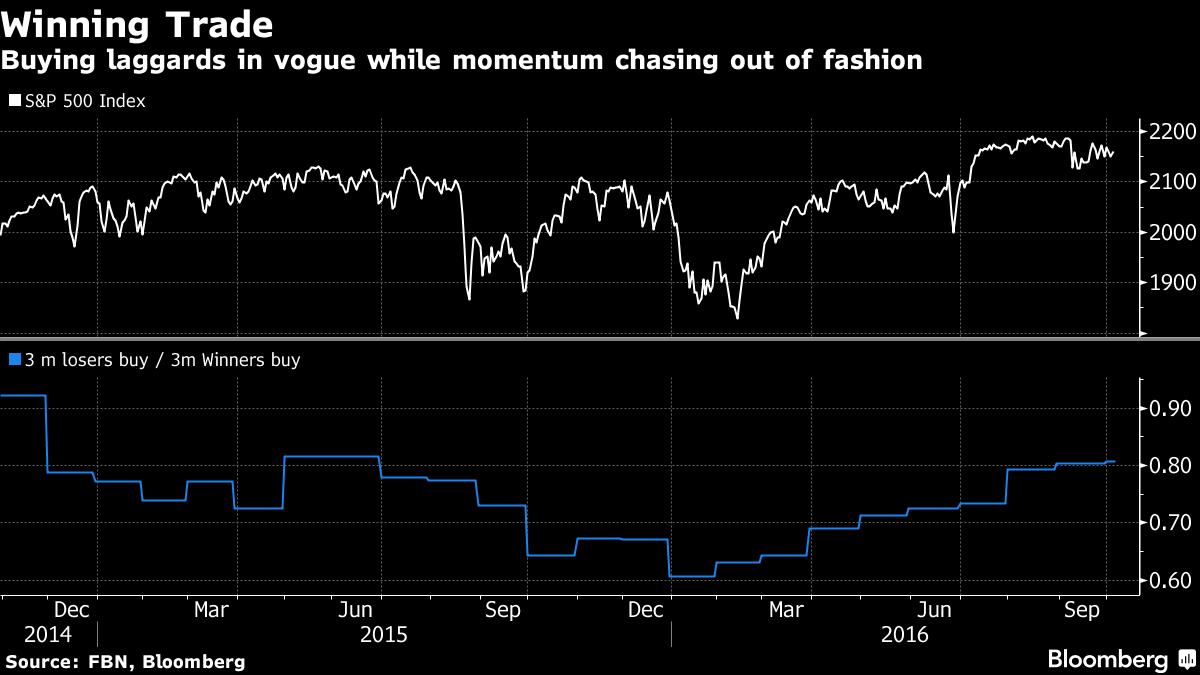Buying S&P 500 3-Month Losers Has Been A Winning Strategy In 2016

Stock Market Dogs Top Darlings as Investors Resist Momentum
*Past losers have beaten past leaders every month since January
*Trend is a stark contrast to 2015, when winners kept winning
by Lu Wang
For stock market investors, 2016 is shaping up as the year of the dog.
Since January, buying the worst-performing stocks over the prior three months has beaten the strategy of wagering on past leaders, delivering a nine-month winning streak that’s the longest since at least 1996, data compiled by FBN Securities and Bloomberg show. The extra return from chasing these so-called dogs has amounted to 33 percentage points, a clear departure from 2015 when buying winners was the trade of the year.
The shift to bargain hunting is a sign that investors are becoming increasingly wary about paying too much for stocks as the bull market approaches its eighth year. While the preference for laggards has helped broaden gains from utilities to energy and technology, the reversal is further complicating a year that’s already shaping up to be one of the worst for stock pickers.
“Last year, fundamental mangers looked like heroes when they put money to work after a steep decline because momentum stocks kept working,” said JC O’Hara, chief market technician at FBN in New York. “2016 is a giant switch. If you were a manager and bought the wrong basket, all of a sudden the market is moving higher and you’re in names that are not working -- you dig yourself into a hole and it’s very difficult to get out.”
Rare Year
Spotting the investing trend in advance matters in a market where a growing number of computerized traders allocate money based on factors such as valuation or company size. When it comes to price momentum, the logic is either buy leaders on the expectation that historic patterns will continue, or bet on laggards catching up in a trade often known as “mean reversion.”
But 2016 has turned out to be one of the rare years when a rush to laggards followed a big period of momentum chasing. FBN ranks S&P 500 Index (SPX) (SPY) members based on their three-month returns and tracks the performance of the top and bottom 50 stocks in two separate baskets. In 2015, market leaders such as biotech (IBB) and Internet (FDN) shares outperformed by 21 percentage points in the best showing for the momentum trade during this bull market. Then their fate started to take a turn. Should the laggard basket keep their edge through December, it’d be their best year since 2009.
The failure of the momentum trade hasn’t dented the popularity of the strategy, at least for now. The iShares Edge MSCI USA Momentum Factor ETF, the largest of such exchange-traded funds with $1.8 billion in assets, has attracted fresh money every month since February even as its return trailed the S&P 500. The benchmark gauge was essentially flat at 9:42 a.m. in New York and is up 5.7 percent in 2016. The momentum ETF has gained 4.4 percent this year.
Embracing Losers
The agony from this drastic shift in trading style is primarily being felt by active managers. While there are many reasons for professional investors to be trailing the market, the sudden switch from losers to winners makes it even harder to navigate through a year when bouts of volatility are erupting more than ever. According to Bank of America Corp., only 16 large-cap funds have beaten their benchmarks since January, putting them on pace for their worst year since at least 2003.
It’s easy to understand why traders are suddenly embracing losers with room to grow, considering how expensive stocks have become. At 18 times forecast earnings, the S&P 500 is at its priciest level since 2002.
Energy shares (XLE), the worst performer in 2015, replaced phone and utility (XLU) companies as the biggest winner in the second quarter, rallying 11 percent, after oil ended its epic slump in February. The leadership then shifted to computer and software companies (XLK) in the following three months, when the stocks rose from the bottom rank, jumping 12 percent.
Who might be the next target of bargain hunting? To O’Hara, one possible candidate is banks (KBE). The group is valued at 1.1 times book value, near a three-year low. While it’s still too early to call, financial shares have led the market this month, as the prospect of higher interest rates prompted a shift out of dividend stocks and into lenders.
“If you’re looking to putting money to work, you want to buy a good stock fundamentally, but you also want to buy a stock that’s actually going to start working in your favor,” O’Hara said. “In this range-trading environment where guys don’t want to own stocks that are too extended and you see this rotation back into unloved sectors like energy, it adds more confidence for managers buying down-and-out stocks.”
Courtesy of bloomberg.com
